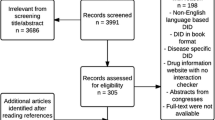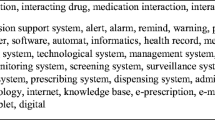Abstract
Purpose
Several electronic databases which report the prevalence of drug-drug interactions (DDIs) are used as a tool for evaluation of potentially harmful DDIs. The aim of our review was to evaluate the usability and appropriateness of commercially available electronic databases which assess the prevalence of potential DDIs.
Methods
The systematic electronic literature search was conducted with the following search terms: “database” AND “software,” and “drug-drug interactions” AND “database,” and the inclusion and exclusion criteria were applied in order to identify the publications of interest.
Results
A total of 3766 papers were identified by systematic search. After applying inclusion and exclusion criteria, 38 publications were included in the analysis. The most commonly used software in the included studies was Micromedex® Drug-Reax, for which some authors argue to be the most reliable due to highest sensitivity. It gives information about clinical consequences of DDIs, classifies underlying mechanism and onset of the adverse outcome (either rapid, or delayed) as well as severity (such as minor, moderate, or major), and provides the level of evidence which supports this information. This data is also provided by Drug Interaction Facts®, Lexi-Interact®, and Pharmavista®. A small number of studies which compared assessment of DDIs with electronic database and the clinician’s assessment showed large discrepancy in number and relevance of detected DDIs. The overlap was in some cases as low as 11 %.
Conclusion
The deficiency of clinical relevance of detected DDIs should be addressed in the upcoming research as it would provide more relevant information to the prescribers’ in clinical practice.

Similar content being viewed by others
References
Askari M, Eslami S, Louws M, Wierenga et al (2013) Frequency and nature of drug-drug interactions in the intensive care unit: frequency of DDIs in the ICU. Pharmacoepidemiol Drug Saf 22(4):430–437
Reis AMM, Cassiani SHDB (2010) Evaluation of three brands of drug interaction software for use in intensive care units. Pharm World Sci 32(6):822–828
Vonbach P, Dubied A, Krähenbühl S et al (2008) Evaluation of frequently used drug interaction screening programs. Pharm World Sci 30(4):367–374
Böttiger Y, Laine K, Andersson ML et al (2009) SFINX—a drug-drug interaction database designed for clinical decision support systems. Eur J Clin Pharmacol 65(6):627–633
Andersson ML, Böttiger Y, Lindh JD et al (2012) Impact of the drug-drug interaction database SFINX on prevalence of potentially serious drug-drug interactions in primary health care. Eur J Clin Pharmacol 69(3):565–571
Fournier J-P, Sommet A, Durrieu G et al (2014) Drug interactions between antihypertensive drugs and non-steroidal anti-inflammatory agents: a descriptive study using the French Pharmacovigilance database. Fundam Clin Pharmacol 28(2):230–235
Leone R, Magro L, Moretti U et al (2010) Identifying adverse drug reactions associated with drug-drug interactions: data mining of a spontaneous reporting database in Italy. Drug Saf Int J Med Toxicol Drug Exp 33(8):667–675
Paterno MD, Maviglia SM, Gorman PN et al (2009) Tiering drug-drug interaction alerts by severity increases compliance rates. J Am Med Inform Assoc 16(1):40–46
Peng CC, Glassman PA, Marks IR et al (2003) Retrospective drug utilization review: incidence of clinically relevant potential drug-drug interactions in a large ambulatory population. J Manag Care Pharm 9(6):513–522
Liberati A, Altman DG, Tetzlaff J et al (2009) The PRISMA statement for reporting systematic reviews and meta-analyses of studies that evaluate health care interventions: explanation and elaboration. PLoS Med 6(7):e1000100
Langdorf MI, Fox JC, Marwah RS et al (2000) Physician versus computer knowledge of potential drug interactions in the emergency department. Acad Emerg Med 7:1321–1329
Cruciol-Souza JM, Thomson JC (2006) A pharmacoepidemiologic study of drug interactions in a Brazilian teaching hospital. Clin São Paulo Braz 61(6):515–520
Straubhaar B, Krähenbühl S, Schlienger RG (2006) The prevalence of potential drug-drug interactions in patients with heart failure at hospital discharge. Drug Saf 29(1):79–90
Rätz Bravo AE, Tchambaz L et al (2005) Prevalence of potentially severe drug-drug interactions in ambulatory patients with dyslipidaemia receiving HMG-CoA reductase inhibitor therapy. Drug Saf 28(3):263–275
Bista D, Saha A, Mishra P et al (2009) Impact of educational intervention on the pattern and incidence of potential drug-drug interactions in Nepal. Pharm Pract 7(4):242–247
Secoli S-R, Figueras A, Lebrão ML et al (2010) Risk of potential drug-drug interactions among Brazilian elderly: a population-based, cross-sectional study. Drugs Aging 27(9):759–770
Fokter N, Mozina M, Brvar M (2010) Potential drug-drug interactions and admissions due to drug-drug interactions in patients treated in medical departments. Wien Klin Wochenschr 122(3–4):81–88
Venturini CD, Engroff P, Ely LS et al (2011) Gender differences, polypharmacy, and potential pharmacological interactions in the elderly. Clin São Paulo Braz 66(11):1867–1872
Guastaldi RBF, Reis AMM, Figueras A et al (2011) Prevalence of potential drug–drug interactions in bone marrow transplant patients. Int J Clin Pharm 33(6):1002–1009
Reis AMM, Cassiani SHDB (2011) Prevalence of potential drug interactions in patients in an intensive care unit of a university hospital in Brazil. Clin São Paulo Braz 66(1):9–15
Lin C-F, Wang C-Y, Bai C-H (2011) Polypharmacy, aging and potential drug-drug interactions in outpatients in Taiwan: a retrospective computerized screening study. Drugs Aging 28(3):219–225
Ismail M, Iqbal Z, Khattak M et al (2011) Prevalence, type and predictors of potential drug-drug interactions in pulmonology ward of a tertiary care hospital. Afr J Pharm Pharmacol 10(5):1303–1309
Teixeira JJV, Crozatti MTL, dos Santos CA et al (2012) Potential drug-drug interactions in prescriptions to patients over 45 years of Age in primary care, Southern Brazil. PLoS ONE 7(10):e47062
Ismail M, Iqbal Z, Khattak M et al (2012) Potential drug-drug interactions in psychiatric ward of a tertiary care hospital: prevalence, levels and association with risk factors. Trop J Pharm Res 11(2):289–296
Ismail M, Iqbal Z, Khattak M et al (2012) Potential drug-drug interactions in cardiology ward of a teaching hospital. HealthMED 6(5):1618–1624
Ba S, Admassie E, Hailu W et al (2013) Extent of poly-pharmacy, occurrence and associated factors of drug-drug interaction and potential adverse drug reactions in gondar teaching referral hospital, North West Ethiopia. J Adv Pharm Technol Res 4(4):183–189
Kashyap M, D’Cruz S, Sachdev A et al (2013) Drug-drug interactions and their predictors: results from Indian elderly inpatients. Pharm Pract 11(4):191–195
Riechelmann RP, Moreira F, Smaletz Ò et al (2005) Potential for drug interactions in hospitalized cancer patients. Cancer Chemother Pharmacol 56(3):286–290
Van Leeuwen RWF, Swart EL, Boven E et al (2011) Potential drug interactions in cancer therapy: a prevalence study using an advanced screening method. Ann Oncol 22(10):2334–2341
Van Leeuwen RWF, Brundel DHS, Neef C et al (2013) Prevalence of potential drug–drug interactions in cancer patients treated with oral anticancer drugs. Br J Cancer 108(5):1071–1078
Bacic-Vrca V, Marusic S, Erdeljic V et al (2010) The incidence of potential drug–drug interactions in elderly patients with arterial hypertension. Pharm World Sci 32(6):815–821
Hadjibabaie M, Badri S, Ataei S et al (2013) Potential drug–drug interactions at a referral hematology–oncology ward in Iran: a cross-sectional study. Cancer Chemother Pharmacol 71(6):1619–1627
Vonbach P, Dubied A, Krähenbühl S et al (2008) Prevalence of drug–drug interactions at hospital entry and during hospital stay of patients in internal medicine. Eur J Intern Med 19(6):413–420
Lubinga SJ, Uwiduhaye E (2011) Potential drug-drug interactions on in-patient medication prescriptions at Mbarara Regional Referral Hospital (MRRH) in western Uganda: prevalence, clinical importance and associated factors. Afr Health Sci 11(3):499–507
Guzek M, Zorina OI, Semmler A et al (2011) Evaluation of drug interactions and dosing in 484 neurological inpatients using clinical decision support software and an extended operational interaction classification system (Zurich Interaction System): drug interactions in neurological inpatients. Pharmacoepidemiol Drug Saf 20(9):930–938
Chatsisvili A, Sapounidis I, Pavlidou G et al (2010) Potential drug–drug interactions in prescriptions dispensed in community pharmacies in Greece. Pharm World Sci 32(2):187–193
Zorina OI, Haueis P, Semmler A et al (2012) Comparative evaluation of the drug interaction screening programs MediQ and ID PHARMA CHECK in neurological inpatients: comparison of drug interaction screening programs. Pharmacoepidemiol Drug Saf 21(8):872–880
Zorina OI, Haueis P, Greil W et al (2013) Comparative performance of two drug interaction screening programmes analysing a cross-sectional prescription dataset of 84,625 psychiatric inpatients. Drug Saf 36(4):247–258
Smithburger PL, Kane-Gill SL, Seybert AL (2010) Drug-drug interactions in cardiac and cardiothoracic intensive care units: an analysis of patients in an academic medical centre in the US. Drug Saf 33(10):879–888
Ko Y, Tan S-LD, Chan A et al (2012) Prevalence of the coprescription of clinically important interacting drug combinations involving oral anticancer agents in Singapore: a retrospective database study. Clin Ther 34(8):1696–1704
Smithburger PL, Kane-Gill SL, Seybert AL (2012) Drug-drug interactions in the medical intensive care unit: an assessment of frequency, severity and the medications involved: drug-drug interactions in the medical ICU. Int J Pharm Pract 20(6):402–408
Obreli Neto PR, Nobili A, Marusic S et al (2012) Prevalence and predictors of potential drug-drug interactions in the elderly: a cross-sectional study in the brazilian primary public health system. J Pharm Pharm Sci 15(2):344–354
Vonbach P, Dubied A, Beer JH et al (2007) Recognition and management of potential drug–drug interactions in patients on internal medicine wards. Eur J Clin Pharmacol 63(11):1075–1083
Bertoli R, Bissig M, Caronzolo D et al (2010) Assessment of potential drug-drug interactions at hospital discharge. Swiss Med Wkly. doi:10.4414/smw.2010.13043
Taegtmeyer AB, Kullak-Ublick GA, Widmer N et al (2012) Clinical usefulness of electronic drug-drug interaction checking in the care of cardiovascular surgery inpatients. Cardiology 123(4):219–222
Marusic S, Bacic-Vrca V, Obreli Neto PR et al (2013) Actual drug–drug interactions in elderly patients discharged from internal medicine clinic: a prospective observational study. Eur J Clin Pharmacol 69(9):1717–1724
Smithburger PL, Kane-Gill SL, Benedict NJ et al (2010) Grading the severity of drug-drug interactions in the intensive care unit: a comparison between clinician assessment and proprietary database severity rankings. Ann Pharmacother 44(11):1718–1724
Dallenbach MF, Bovier PA, Desmeules J (2007) Detecting drug interactions using personal digital assistants in an out-patient clinic. QJM 100(11):691–697
Brager R, Sloand E (2005) The spectrum of polypharmacy. Nurse Pract 30(6):44–50
Zarowitz BJ, Stebelsky LA, Muma BK et al (2005) Reduction of high-risk polypharmacy drug combinations in patients in a managed care setting. Pharmacotherapy 25(11):1636–1645
Frazier SC (2005) Health outcomes and polypharmacy in elderly individuals: an integrated literature review. J Gerontol Nurs 31(9):4–11
Fulton MM, Allen ER (2005) Polypharmacy in the elderly: a literature review. J Am Acad Nurse Pract 17(4):123–132
Libby AM, Fish DN, Hosokawa PW et al (2013) Patient-level medication regimen complexity across populations with chronic disease. Clin Ther 35(4):385–398
Wongpoowarak W, Wongpoowarak P (2002) Unified algorithm for real-time detection of drug interaction and drug allergy. Comput Methods Programs Biomed 68(1):63–72. http://www.ncbi.nlm.nih.gov/pubmed/11886703
Barrons R (2004) Evaluation of personal digital assistant software for drug interactions. Am J Health Syst Pharm 61(4):380–385
Paciullo CA (2013) Book review: Stockley’s Drug Interactions 10th ed. London, UK: Pharmaceutical Press; 2013. Ann Pharmacother 47(10): 1376
Conflicts of interest
The authors have no conflicts of interest to declare.
Author information
Authors and Affiliations
Corresponding author
Electronic supplementary material
Below is the link to the electronic supplementary material.
ESM 1
(DOCX 21 kb)
Rights and permissions
About this article
Cite this article
Roblek, T., Vaupotic, T., Mrhar, A. et al. Drug-drug interaction software in clinical practice: a systematic review. Eur J Clin Pharmacol 71, 131–142 (2015). https://doi.org/10.1007/s00228-014-1786-7
Received:
Accepted:
Published:
Issue Date:
DOI: https://doi.org/10.1007/s00228-014-1786-7




